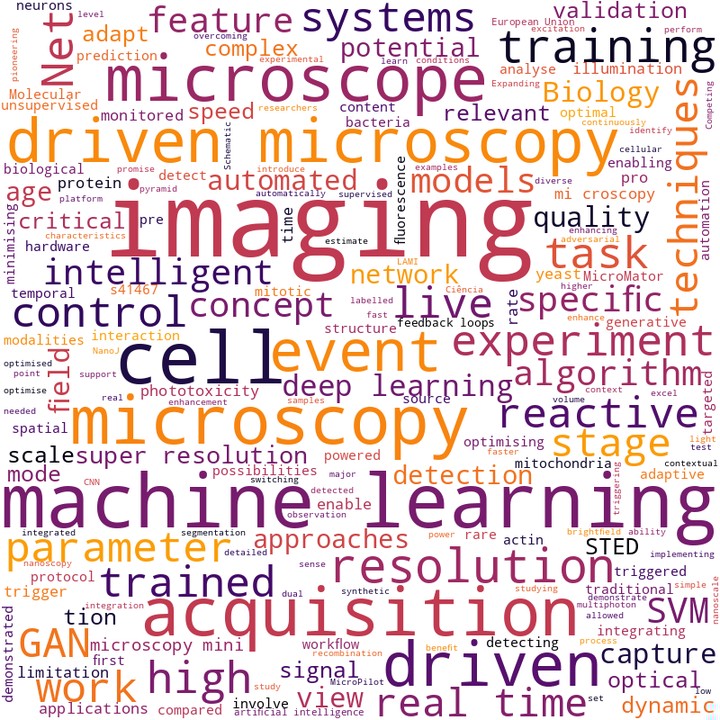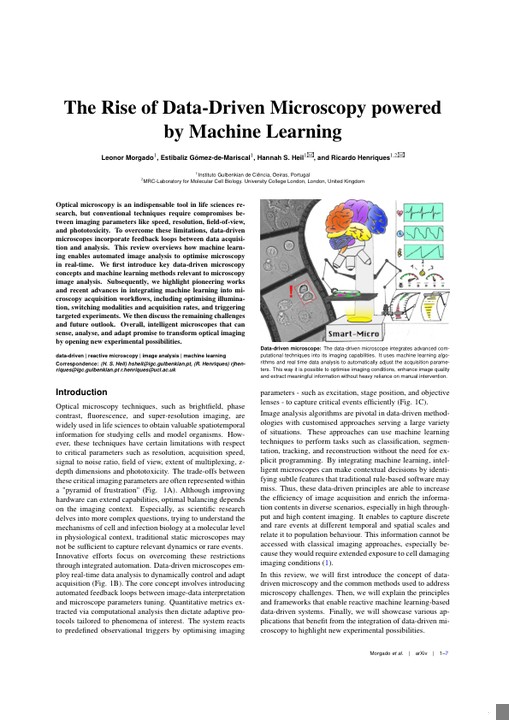Behind the Preprint - The Rise of Data-Driven Microscopy powered by Machine Learning
Posted on Mon 15 January 2024 in behind the preprint
Key ideas
We discuss how combining machine learning and real-time data analysis is transforming optical microscopy into intelligent, adaptive systems. We overview the vision of data-driven microscopes that can automatically optimize illumination, resolution, speed and other parameters by sensing and reacting to imaging data.
The core principles involve creating feedback loops between quantitative image analysis and microscope control. Algorithms are trained to recognize phenomena of interest within images. Once a target event is detected, the microscope can alter settings to zoom in, switch modalities, increase frame rate or trigger additional experiments.
This allows microscopes to efficiently capture dynamic information and rare occurrences that would be difficult or impossible to obtain manually. By continuously optimizing data collection, intelligent imaging platforms promise to accelerate discoveries across the life sciences.
Origins and Motivations
We have a long-standing interest in the intersection of machine learning and microscopy. Our lab has been working on developing open-source super-resolution imaging and analysis tools for years. We are also exploring how to integrate deep learning into image-processing pipelines. Our research focuses on infection and cell cycle, where we need to detect and track rare events in noisy data. Therefore, we are interested in developing some of these technologies in-house, as well as seeing the field progress through the excellent work of others.
When we started out lab, I became committed to developing accessible imaging technologies that could help researchers overcome inherent limitations. Our early work on real-time super-resolution feedback loops got me interested on the concept of data-driven microscopy.
In Focus
In this preprint, we aimed to provide a short overview focused specifically on machine learning-powered reactive microscopy systems. We introduce concepts and methods, highlight pioneering works demonstrating the potential across different modalities, and discuss remaining challenges.
The preprint makes it clear that the integration of automation, image analysis and microscopy is rapidly gaining traction. We showcase applications in optimizing illumination, triggering targeted experiments, enhancing resolution, and more. Still, we emphasize critical questions around robustness, validation, and accessibility that need addressing as the field matures.
Implications and Impact
The field of microscopy has long been striving towards the development of smart microscopes. In the past, companies like Nikon and Zeiss have provided software control interfaces for their microscopes, allowing users to automate image acquisition. With the advent of machine learning, the field is now moving towards the creation of intelligent microscopes that can adapt to the data they collect.
An interesting question arises regarding the development of these intelligent microscopes: will they be created by microscope companies or by the scientific community? If the latter is the case, open-source tools will need to be developed to enable the community to create their own intelligent microscopes. Our lab is currently pursuing this path.
Another important question is where the balance between the microscope AI and the user will lie. Will the microscope control the experiment entirely, or will the user have full control over the microscope? The answer lies somewhere in between, with the user setting the experiment parameters and the microscope adapting to the data it collects.
It is also essential to consider where the AI will reside. Will it be in-house, in the cloud, or both? This raises some interesting questions concerning data privacy, ownership, and accessibility. However, one thing is clear: AI is here to stay and will revolutionize how we conduct microscopy.
By the Authors
Overview by Ricardo Henriques, preprint originally written by Leonor Morgado, Estibaliz Gómez de Mariscal and Ricardo Henriques.

